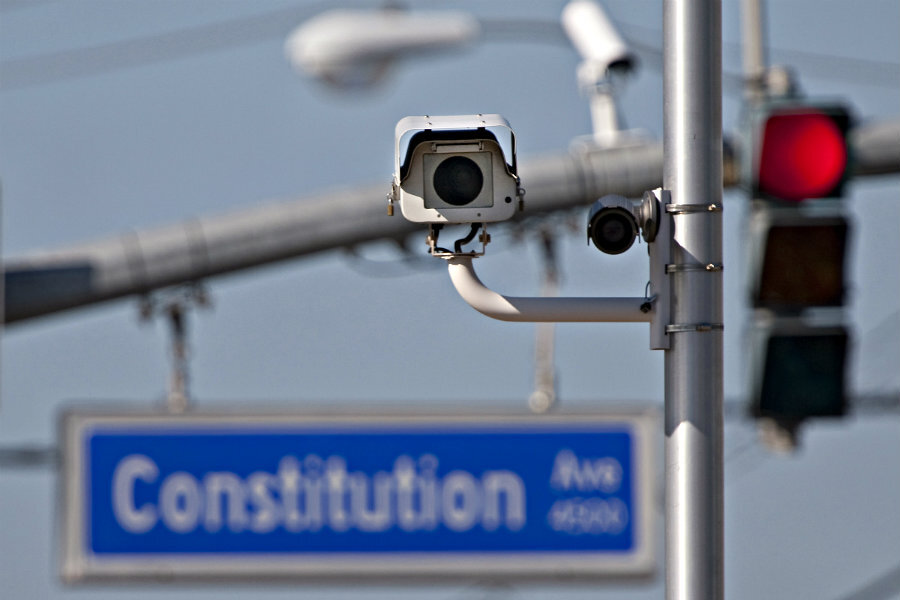Are traffic enforcement cameras worth the effort?
Loading...
A county judge has ruled that the revenues from new traffic enforcement cameras in a small village in southwest Ohio will not be used to settle a $1.8 million dollar lawsuit over an earlier traffic camera program.
Motorists in the town of New Miami, Ohio, requested that the town pay the damages they are owed following their victory in a 2013 class action case, in which motorists claimed the town had violated their due process rights through the use of speed cameras at intersections, using money collected by new handheld speed cameras. But Butler County Judge Michael A. Oster rejected the idea, calling garnishment an “extraordinary remedy,” according to a local newspaper, saying that there is no evidence that the new program is trying to defraud drivers.
Traffic enforcement cameras, used to enforce speed limits and red lights, are becoming increasingly common. As of 2009, they were in use in approximately 400 cities and towns around the country – and simultaneously increasingly controversial. Communities from Texas to Illinois to Ohio have all engaged in dialogue and sometimes legal action around the issue. With so much at stake, are red-light cameras worthwhile for towns like New Miami?
“The way the cameras are implemented makes a big difference,” says Ohio State University law professor Ric Simmons. “People react to the cameras very differently depending on the way they used.”
The tiny town of New Miami is not alone in encountering opposition to the placement of speed cameras and other traffic devices. Local law enforcement says that such cameras can save towns money by enforcing traffic laws without requiring the presence of police officers.
“It keeps us mobile instead of having to make traffic stops up there,” New Miami Police Department’s Sgt. Angela Rebholz told the Oxford Townie, a local newspaper, in 2013. “It’s doing the job for us and keeping us from having to sit up there all the time.”
Yet despite the potential benefits, many see speed and red-light cameras as little more than revenue generators for towns like New Miami. Mr. Simmons told The Christian Science Monitor in a telephone interview that oftentimes small towns don’t review photographs taken by the camera to see if traffic violations have really occurred, or even if police are sending citations to the right individuals.
Municipalities have also been criticized for using revenue generated by the cameras for general operating budgets, and not for infrastructure purposes. In some areas, critics even say that municipalities shortened yellow light times in concord with the installation of red-light cameras, increasing the likelihood of traffic violations and raising local revenue.
In the 2013 case regarding New Miami’s red-light cameras, motorists argued that the town’s procedures violated citizens’ due process rights under the Constitution. Drivers had little opportunity to appeal, they said. When the notification of a traffic violation came in the mail, drivers could either pay a fine (thereby admitting liability for the violation) or request a hearing.
But drivers in New Miami and surrounding towns felt that appealing the claim of a camera, even if they were certain they had been driving the speed limit at the time of the violation, would do little to help them.
“What am I going to do, contest it? Take a day off work?” Oxford, Ohio, resident Jim McWilliams told the Oxford Townie at the time. “I have nothing to stand on. I’m not a hooligan or anything, but what judge is going to believe me over a computer?”
Local motorists won their case, though the town has since appealed, and the case is now before the state Supreme Court. The winners of that lawsuit, however, requested that the $1.8 million they were awarded be paid by garnishing the fines collected by the new traffic cameras.
Yet for all the hassle that red-light cameras cause for police, many are uncertain whether or not traffic cameras help alleviate harmful crashes, or whether they merely cause more strife for drivers.
“We want people to obey the law and drive safely,” says Shelia Dunn, the communications director for the National Motorists Association, which opposes electronic traffic devices such as red-light cameras, “but if you put such draconian measures in place, it is difficult for motorists to get through the day.”
In California, for example, red-light cameras that catch motorists executing a rolling stop can lead to the issuance of $490 tickets for a single violation.
One in 8 people in Virginia are driving with a suspended license, Ms. Dunn told the Monitor by phone, because they cannot afford to pay their tickets.
There is also conflicting data on whether red-light cameras actually make intersections safer.
“There are many communities that have noticed that crashes increase in intersections with red-light cameras,” says Dunn.
The National Motorists Association website points to several reports of red light cameras increasing the number of accidents at given intersections. One Washington Post report written in 2005 found that accidents at intersections with cameras increased from 365 crashes in 1998 to 755 in 2004. However, crashes at intersections with traffic signals but no cameras also climbed dramatically in that time.
Another study, conducted by the Federal Highway Administration in 2005 in jurisdictions across the United States, found that while right angle crashes decreased by nearly 25 percent in intersections with traffic cameras, rear end crashes increased by 15 percent over that same period.
With safety statistics murky, and critics abounding, red-light cameras may be more trouble than they are worth for municipalities.
In Ohio, for example, although red-light cameras were officially intended to decrease the amount of time police must spend monitoring intersections, the state legislature recently passed legislation that requires police officers to be present at intersections with traffic cameras. This legislation hamstrings local police departments, and essentially makes cameras pointless.
“Red-light cameras were a good way to make money when they first became popular,” says Mr. Simmons, “but litigation is expensive, and now they are a hassle for many towns.”








